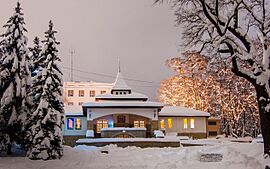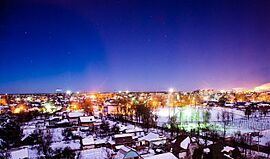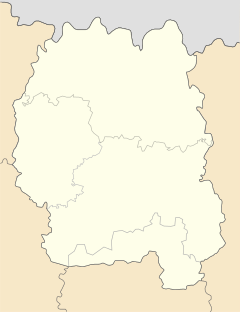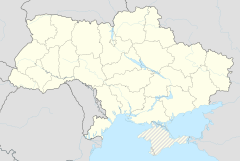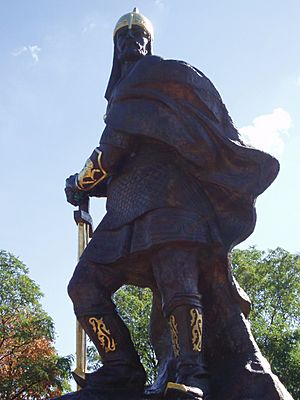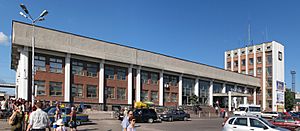Korosten facts for kids
Quick facts for kids
Korosten
Коростень
|
|||
|---|---|---|---|
|
|||
| Country | |||
| Oblast | Zhytomyr Oblast | ||
| Raion | Korosten Raion | ||
| Hromada | Korosten urban hromada | ||
| First mentioned | 945 | ||
| Charter granted | 1589 | ||
| City Status | 1 January 1926 | ||
| City council | Korosten City Council | ||
| Area | |||
| • Total | 42.31 km2 (16.34 sq mi) | ||
| Elevation | 171 m (561 ft) | ||
| Population
(2022)
|
|||
| • Total | 61,496 | ||
| • Density | 1,453.46/km2 (3,764.5/sq mi) | ||
| Time zone | UTC+2 (EET) | ||
| • Summer (DST) | UTC+3 (EEST) | ||
| Postal code |
01xxx–04xxx
|
||
| Area code(s) | +380 44 | ||
| FIPS code | UP27 | ||
| Vehicle registration plate | AМ | ||
Korosten (Ukrainian: Коростень) is a historic city in northern Ukraine. It is located in the Zhytomyr Oblast region, right on the Uzh River. Korosten is an important transport hub and serves as the main city for the Korosten Raion area. As of January 2022, about 61,496 people live in Korosten.
Contents
What's in a Name? The Origin of Korosten
There are a few ideas about how Korosten got its name.
From Nature: Bushes and Bark
One idea is that the name comes from the word korost, which means 'brushwood' or 'bushes'. The old name, Iskorosten, might have come from an old Slavic way of saying "from the city from...".
Another theory says the city was built mostly from wood. Its walls were surrounded by a fence made of oak trees with their bark still on. This led to the name Is-koro-sten, meaning "from bark on the wall" in Ukrainian.
From a God: Khors
Some people believe the city was named after Khors, a sun god. Khors was an important god for many tribes in the area, including the Drevlians. This theory suggests that other cities like Korsun and Korostyshiv also got their names from Khors.
Korosten's Long History
Korosten is a very old city, founded over a thousand years ago. It was once the capital city of the Drevlians, an ancient Slavic tribe.
Early Days with the Rus
![]() Kievan Rus' 879-1097
Kievan Rus' 879-1097
![]() Principality of Kiev 1097–1240
Principality of Kiev 1097–1240
![]() Golden Horde 1240–1363
Golden Horde 1240–1363
![]() Grand Duchy of Lithuania 1363–1569
Grand Duchy of Lithuania 1363–1569
![]() Polish–Lithuanian Commonwealth 1569–1649
Polish–Lithuanian Commonwealth 1569–1649
![]() Cossack Hetmanate 1649-1667
Cossack Hetmanate 1649-1667
![]() Polish–Lithuanian Commonwealth 1667-1795
Polish–Lithuanian Commonwealth 1667-1795
![]() Russian Empire 1795–1917
Russian Empire 1795–1917
![]() Russian Republic 1917
Russian Republic 1917
![]() Various Ukrainian states 1917–1920
Various Ukrainian states 1917–1920
![]() Soviet Ukraine 1920–1922
Soviet Ukraine 1920–1922
![]() Soviet Union 1922–1991 (Occupied by Nazi Germany between 1941-1943)
Soviet Union 1922–1991 (Occupied by Nazi Germany between 1941-1943)
![]() Ukraine 1991–present
Ukraine 1991–present
In 945, Igor of Kiev, the ruler of the Kievan Rus, was killed by the Drevlians in Iskorosten. He was trying to collect tribute (a payment) from them for the second time in a month. The Drevlians were very angry about this.
Igor's wife, Olga of Kiev, became the ruler for their young son. She decided to get revenge on the Drevlians. Olga led her army to Iskorosten and surrounded the city. The siege lasted for a year, but the Drevlians would not give up.
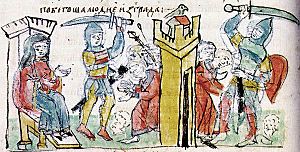
Olga then came up with a clever plan. She sent a message to the Drevlians, asking for a small gift instead of tribute: three pigeons and three sparrows from each house. The Drevlians were happy because they thought the siege would end for such a small price, so they agreed.
That night, Olga's soldiers tied small pieces of burning sulfur to each bird. When the birds were released, they flew back to their nests inside the city. Soon, the entire city caught fire. As people fled the burning city, Olga's soldiers captured them. Some were killed, and others were taken as slaves. This event is a famous story in Ukrainian history.
The Middle Ages and Beyond
After the Rus lands were divided in 1097, Iskorosten remained part of the Kyiv region. In 1240, the city was attacked and burned by the Mongols, led by Batu Khan. The Mongols, part of the Golden Horde, ruled the area for many years.
Later, in 1362 or 1363, the Grand Duchy of Lithuania took control of these lands. In 1589, Iskorosten was officially granted city status by the Polish king.
Changes and Conflicts
In 1649, during the Khmelnytsky Uprising, Cossacks captured Iskorosten from Polish defenders. The city's defenses were destroyed. From 1667 to 1795, the area around Iskorosten was part of the Polish–Lithuanian Commonwealth.
In 1795, after the Third Partition of Poland, Iskorosten became part of the Russian Empire. For a long time, it was a quiet town. However, in 1902, the construction of the Kyiv-Kovel railway helped the town grow into a major railway hub. A porcelain factory also opened in 1909, bringing more industry. In 1917, the town was officially renamed Korosten.
Korosten During the Civil War
After the Russian Revolution in 1917, Ukraine faced a period of conflict. The Ukrainian Central Council declared Ukraine's independence. Korosten became an important location during this time, as different forces fought for control. The Ukrainian Central Council even approved the Trident of St. Vladimir as Ukraine's national symbol while in Korosten in 1918.
The city changed hands many times between Ukrainian, Bolshevik (Red Army), German, and Polish forces. It was a frontline city during these turbulent years.
Between the World Wars
In 1926, Korosten officially became a city. Like many places in Ukraine, Korosten suffered greatly during the Holodomor of 1932-1933. This was a terrible man-made famine that caused many people to lose their lives.
By 1936, Korosten had grown to a population of 28,000. It had a porcelain factory, a metalworking factory, and car repair shops.
World War II and Its Impact
During World War II, Korosten was occupied by the German Army from August 1941 to December 1943. The city was heavily damaged and almost completely destroyed during the war.
During the occupation, many Jewish people living in Korosten faced terrible persecution. Over 6,000 Jewish residents were killed between 1941 and 1942. The city was finally liberated by Soviet forces in December 1943.
After the War: Rebuilding and New Challenges
After World War II, a huge effort was made to rebuild Korosten. New buildings and facilities were constructed for the citizens.
In 1986, the nearby Chornobyl nuclear power plant had a major accident. Korosten, being about 90 kilometers away, received a lot of fallout. This event had a big impact on the city and its economy.
Modern Korosten: Independence and Growth
After Ukraine gained independence in 1991, Korosten continued to develop. In 2006, it received an international quality certificate, showing its commitment to high standards.
In 2014, a statue of Vladimir Lenin, a leader of the Soviet Union, was taken down in Korosten. This was part of a larger movement across Ukraine to remove symbols of the Soviet past.
In February 2022, when the Russian invasion of Ukraine began, Korosten held emergency meetings to prepare for the situation.
Symbols of the City: Flag and Coat of Arms
Korosten has its own special flag and coat of arms, which tell stories about its history.
The City Flag
The flag of Korosten has two equal horizontal stripes. The top stripe is blue, and the bottom stripe is red. A wavy stripe, representing the Uzh River, separates them. This river stripe is blue in the middle with golden banks.
- The blue color on the flag symbolizes the city's greatness and beauty.
- The red color represents the bravery of the Drevlian defenders in 946, when Princess Olga besieged the city. It also honors the defenders of Korosten during World War II.
The City's Coat of Arms
The coat of arms of Korosten shows a dark red fortress wall on a blue shield. This wall reminds us of the city's strong defenses in the past. A green flax stem and a four-petal red flower are shown against the wall, symbolizing the nature of the Polissya region and the ancient settlements along the Uzh River. The river itself is shown as a blue stripe with golden banks.
Above the fortress wall, the name "KOROSTEN" is written in Ukrainian letters. At the bottom of the shield, there's a motto: "DOES NOT BURN IN A FLAME." This motto refers to the city's resilience, especially after being burned by Princess Olga. The shield is topped with a special crown made of wooden walls, reminding us of the Drevlian times.
Economy: Building for the Future
Korosten has an area called the Korosten Industrial Park (KIP). This is a large zone where new factories and businesses are being built. The goal is to create high-tech companies and light industries, like those that assemble products or work with metals and electronics.
This project is planned to last for 10 years and aims to bring new jobs and economic growth to the city. It includes building roads, railways, and providing electricity and water. One of the first big projects was building a factory to make MDF boards, which are used in furniture and construction.
Transport: A Hub for Travel
Korosten is a very important railway junction. It connects major railway lines, including those going to Kyiv and Belarus. This means many trains from Western Ukraine to Kyiv pass through Korosten.
The city has regular train services to and from Kyiv, and many local trains connect Korosten to nearby towns and cities. You can also find regular bus routes that leave from the railway station and the bus station, connecting Korosten to other places.
Major Roads
The Invalid type: M and ![]() E583 trunk roads pass north of Korosten, connecting it to other parts of Ukraine. The Invalid type: M and
E583 trunk roads pass north of Korosten, connecting it to other parts of Ukraine. The Invalid type: M and ![]() E373 roads also connect the city to places like Zhytomyr and Vinnytsia.
E373 roads also connect the city to places like Zhytomyr and Vinnytsia.
People of Korosten
According to the 2001 census, most people in Korosten are Ukrainian (89%). There are also significant numbers of Russian (7.5%), Polish (1.5%), Belarusian (0.6%), and Jewish (0.5%) people living in the city.
Population Growth Over Time
| 1939 | 1959 | 1979 | 1989 | 2001 | 2018 |
|---|---|---|---|---|---|
| 30,806 | 38,041 | 65,333 | 72,367 | 66,669 | 63,525 |
Languages Spoken (2001)
| Ukrainian | Russian |
|---|---|
| 86.69 % | 12.73 % |
Potato Pancakes Festival
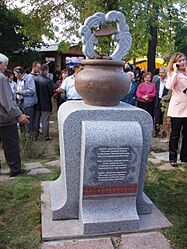
Every year, on the third Saturday of September, Korosten hosts a fun International potato pancakes festival! Potato pancakes are called deruny (Ukrainian: деруни) in Ukrainian.
During the festival, there are exciting competitions, including a "potato pancakes triathlon":
- "Potato pancakes powerlifting" - Squatting while holding two heavy jugs full of pancakes!
- Throwing potato pancakes - Trying to throw pancakes into a bowl of sour cream from 5 meters away.
- Pancake toss - Throwing pancakes to a friend from 5 meters away.
There's also a "potato pancakes school" where experienced cooks teach everyone how to make these delicious pancakes. The most exciting part is the competition for the tastiest pancake, judged by a special jury. Anyone can become a jury member by getting a "patent" for a small fee.
The festival also features various other competitions, exhibitions, tastings of traditional Polesian drinks, and performances by folk music groups. It's a lively and tasty event for everyone!
Twin Towns and Sister Cities
Korosten has special partnerships with other cities around the world. These are called "twin towns" or "sister cities." They work together on cultural exchanges and other projects.
 Anenii Noi, Moldova (2006)
Anenii Noi, Moldova (2006) Kraśnik, Poland (2007)
Kraśnik, Poland (2007) Sloviansk, Ukraine (2014)
Sloviansk, Ukraine (2014) Svitlovodsk, Ukraine (2005)
Svitlovodsk, Ukraine (2005) Volodymyr, Ukraine
Volodymyr, Ukraine Bourges, France (2022)
Bourges, France (2022)
Gallery
-
Saint Olga Orthodox church in Korosten
See also
 In Spanish: Kórosten para niños
In Spanish: Kórosten para niños


